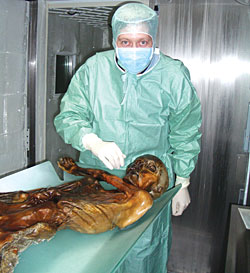 |
Imagine stumbling into the oldest moist mummy in the world while trekking. This is exactly what happened to a German couple in 1991 when they were hiking in the Alps in the South Tyrol region of Italy. They alerted the local police thinking it was a possible crime scene, but were shocked to discover that the body they had discovered was the well-preserved natural mummy of a man who lived about 5,300 years ago.
Otzi was carrying an axe, a bear fur cap, and bow and arrows at the time of his death. A reconstruction of Otzi would have looked like what greets you at the Archaeological Museum in Bolzano, Italy (www.iceman.it). In the museum Otzi now 'lives' behind an eight centimetre thick pane of bulletproof glass. The humidity inside the case is 98 per cent and the temperature is minus six degrees centigrade, to simulate the environment in the Alps where he was found.
Extensive radiological exams indicate Otzi died of injuries sustained on the run, including being hit on his right shoulder by a flint-tipped arrow. He eventually succumbed to his wound in the Otzal Alps, hence his name.
This mummy, thought to be between 35 to 55 years of age, has turned out to be a scientific treasure trove. It is hoped that Otzi's DNA will shed new light on hereditary diseases, common neurological problems like Parkinson's disease, and even infertility.
Clearly there is also immense anthropological interest in the Iceman. Radiocarbon dating tests have confirmed that he lived in the early Copper Age and probably was a person of high standing in the community as he was over 35 years old before he died, a ripe old age back then.
Amazingly, the Iceman has more than 50 tattoos on his body, mostly located in the joint areas. The tattooing technique seems modern, using tiny incisions made in the skin into which vegetal coal was rubbed; certain communities in Asia and Africa continue to use this technique to this day.
Radiological examination of his bones showed age and strain-induced or wear-and-tear degeneration in the joints, and as the tattoos correspond to skin acupuncture lines, it has been postulated that tattooing may have been a form of medicinal treatment rather than a shamanistic practice. If true, we can sympathise with Otzi, who may have had age-related painful joints (osteoarthritis), and searched for an effective pain-relieving treatment, just as many of us do today.


